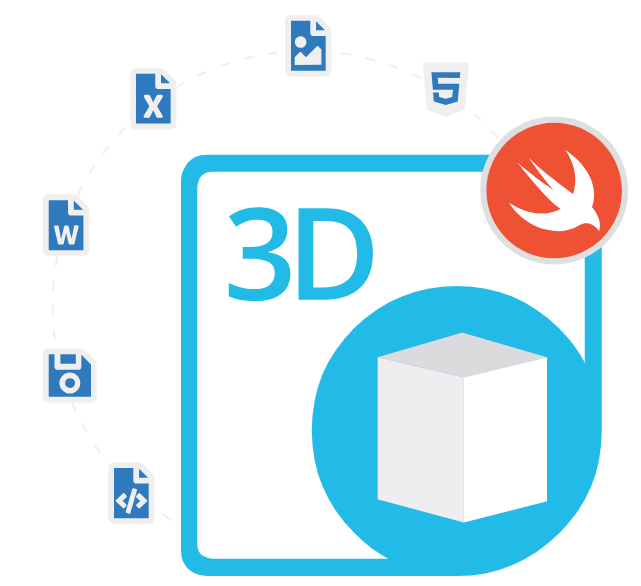
Aspose.3D Cloud SDK for Swift
Swift SDK to Generate, Edit & Convert 3D Models
A Powerful 3D Software Development Kit (SDK) That allows Swift Developers to Create, Modify, Render, Manipulate, and Convert 3D File Formats.
What is Aspose.3D Cloud SDK for Swift?
In the field of software development, there’s a growing need for handling 3D graphics. With the surge in virtual reality, gaming, and animation sectors, developers require effective tools for managing 3D models and assets. steps in to help out by offering a simple method to integrate 3D manipulation features into your Swift-based apps, all while making the most of cloud technology. The SDK makes it easier for software developers like you to handle demanding tasks without dealing with tricky local installations or costly hardware upgrades. It supports numerous 3D popular file formats and enables software developers to create and convert between numerous popular 3D file formats such as FBX, 3DS, U3D, 3MF, DAE, GLTF, STL, OBJ, DRC, RVM, PDF, AMF, PLY, X, JT, DXF, ASE, VRML, HTML and so on.
The Aspose.3D Cloud SDK for Swift is a handy tool for software developers. It comes with rendering features that let you create top-notch images and animations from 3D models. This tool is vital for displaying and highlighting 3D elements in your apps, presentations, or marketing content. In essence, the Aspose.3D Cloud SDK for Swift is a valuable asset for Swift developers dealing with 3D models. The SDK provides a wide range of tools for adjusting 3D models. It enables developers to easily scale, rotate, and modify models, optimize mesh, resize, reorient, and streamline geometry for better performance. These functions are user-friendly and cost-effective for software developers like you. One great thing about it is that it can work with different file types, manage model tasks, get model details, and smoothly convert files – all of which makes it a top pick for adding 3D features to your apps.
Getting Started with Aspose.3D Cloud SDK for Swift
Register an account at Aspose Cloud Dashboard to get you application information. Next, add the POD to your project as follows
Install Aspose.3D Cloud SDK for Swift via CocoaPods
target 'MyApp' do
pod 'Aspose3DCloud', '~> 20.5.1'
end
You can download the compiled shared library from Aspose.3D Cloud SDK for Swift product page.
Convert 3D Files to Other Formats via Swift
Aspose.3D Cloud SDK for Swift has included a very powerful 3D diagrams convert that enables software developers to convert 3D files from one format to another with ease. This feature proves invaluable when dealing with compatibility issues between different software and platforms. With a few lines of Swift code, developers can effortlessly convert a 3D model from one format to another, ensuring seamless integration into their projects. By leveraging the SDK's conversion capabilities, developers can ensure seamless data exchange between systems, opening up possibilities for collaboration and integration. The following example shows how to convert a 3D FBX file to PDF inside Swift applications.
How to convert 3D FBX File to PDF using Swift API?
// Get your ClientId and ClientSecret from https://dashboard.aspose.cloud (free registration required).
let threeDCloudApi = ThreeDCloudApi(grantType: 'client_credentials', clientId: "MY_CLIENT_ID", clientSecret: "MY_CLIENT_SECRET");
let name:String = "sample.fbx"
let newformat:String = "pdf"
let newfilename:String = "oaptest.pdf"
let folder:String? = "Swift"
let isOverwrite:Bool? = true
let storage:String? = STROAGR_NAME
let uploadFile(name: name, folder: folder!)
let threeDCloudApi.postConvertByFormat(name: name, newformat: newformat, newfilename: newfilename, folder: folder, isOverwrite: isOverwrite, storage: storage)
3D Diagrams Rendering in Swift Apps
Aspose.3D Cloud SDK for Swift makes it easy for software developers to render 3D diagram inside their Swift applications. Furthermore, the SDK offers rendering capabilities that enable developers to generate high-quality images and animations from 3D models. This feature proves crucial when visualizing and showcasing 3D assets in applications, presentations, or marketing materials. With the SDK's rendering functionalities, developers can produce stunning visuals that captivate users and bring their 3D projects to life.
Create & Manipulate 3D Models via Swift API
Aspose.3D Cloud SDK for Swift has provided the capability to create new 3D models in various formats and manipulate existing models with ease. The library has included support for a wide range of industry-standard 3D file formats. Whether you're working with popular formats like OBJ, STL, FBX, or more specialized formats like 3DS and Collada, the SDK has you covered. The Swift library enables developers to perform a wide array of manipulations on 3D models. Whether it's scaling, rotating, translating, or applying complex transformations, the SDK provides an intuitive and straightforward API for developers to work with.
How to Creates Simple 3D Diagram & Render It to Produce Image via Swift API?
import AsposeThreeDCloud
// Create a scene
let scene = Scene()
// Create a box shape
let box = BoxShape(width: 2, height: 2, depth: 2)
// Set box properties
box.position = Vector3(x: 0, y: 0, z: 0)
box.color = Color(r: 255, g: 0, b: 0)
// Add the box to the scene
scene.rootNode.addChildNode(box)
// Create a sphere shape
let sphere = SphereShape(radius: 1)
// Set sphere properties
sphere.position = Vector3(x: 0, y: 2, z: 0)
sphere.color = Color(r: 0, g: 0, b: 255)
// Add the sphere to the scene
scene.rootNode.addChildNode(sphere)
// Render the scene
let renderer = Renderer()
let renderedImage = renderer.render(scene)
// Save the rendered image to a file
renderedImage.save(to: "path/to/output/image.png")
Extract Information from 3D Model via Swift
Aspose.3D Cloud SDK for Swift has included powerful features that allows developers to extract information from 3D models. This can be particularly useful when building applications that require access to metadata or specific attributes of a model. The SDK provides methods to retrieve details such as mesh statistics, vertex count, material information, and much more, empowering software developers to create intelligent applications that make use of 3D model data.
